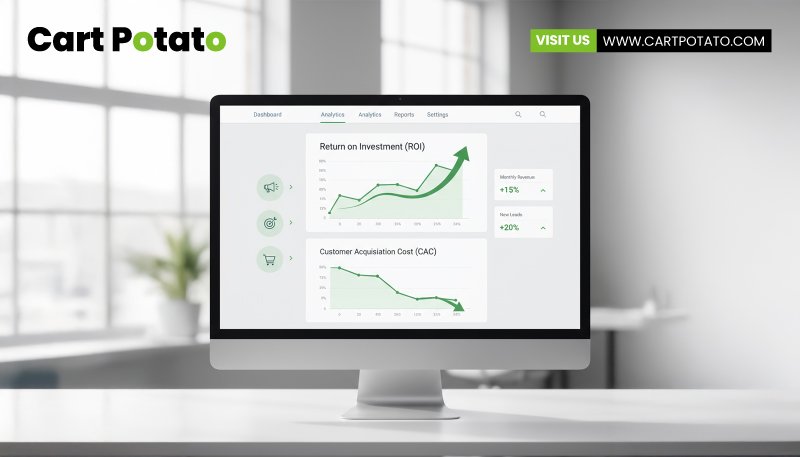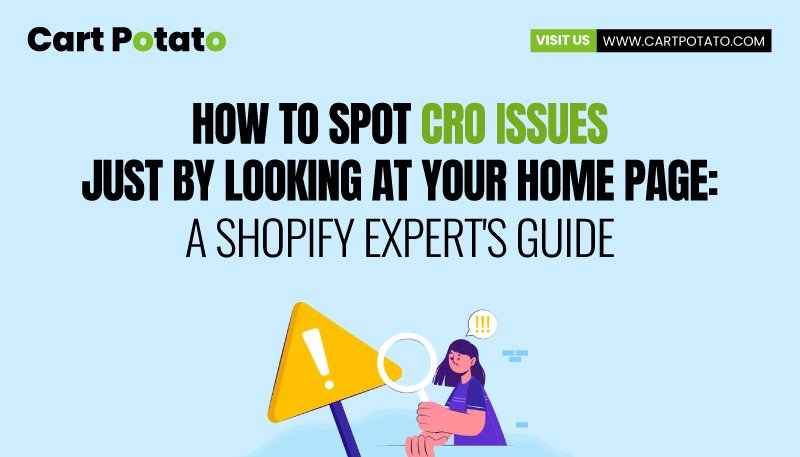
Tips for Beautiful Ecommerce Website Design
A visually captivating and distinctive ecommerce website design is crucial for driving online sales and building an effective marketing strategy.
Research reveals that it takes just 50 milliseconds for visitors to form an opinion about your ecommerce site and decide whether to stay or leave. With such a brief window to make an impression, the design of your website becomes a critical factor in the success of your ecommerce business.
Whether you’re launching your first online store or considering a redesign of your existing site, this guide will help. Explore examples of beautifully designed ecommerce websites, learn tips for selecting the right ecommerce platform, and discover expert advice to make your online business stand out. At Cart Potato, a Shopify and Shopify Plus exclusive agency, we’re dedicated to helping businesses like yours create exceptional ecommerce experiences.
4 Key Elements of Exceptional Ecommerce Website Design
The most successful ecommerce websites share a common focus: they prioritize the user experience from the moment a visitor lands on the site, all the way through to post-purchase. To ensure your ecommerce website delivers an outstanding experience, there are four essential elements that every business should incorporate into their design.
1. Establishing Trust with Customers
When a potential customer visits your online store for the first time, they may know little to nothing about your brand, the quality of your products, or your dedication to customer satisfaction. While enticing offers may grab their attention, building trust is crucial to converting that interest into a sale.
Customer trust can be hard to establish, especially when you’re just starting out. Incorporating these key trust signals into your website design will help instill confidence in your visitors:
- Contact Information: Ensure you have a clearly accessible Contact page that includes an email address and, if possible, a phone number and mailing address. Including this information, along with a well-crafted About page, helps assure customers that they’re buying from a real, reliable business.
- Clear Return Policy: Offering a return policy not only makes it easier for customers to return unsatisfactory products, but it also reduces shopping cart abandonment. It shows customers that they can shop with confidence, knowing they can return items without hassle or hidden fees.
- Technical Certifications: With Shopify Payments integrated into your site, you gain access to the latest security features that safeguard your customers’ information. Display security badges and accepted payment methods prominently to further build trust.
- Customer Reviews and Testimonials: Leverage app integrations that allow you to showcase user-generated content like customer reviews, testimonials, and even social media feeds. Positive reviews and authentic customer photos provide powerful social proof and demonstrate your brand’s credibility.
2. Crafting a Visually Engaging Experience
When it comes to selling products online, perception is everything. Visitors form their first impressions of your ecommerce store in just a matter of milliseconds, so creating an impactful visual experience is critical. The foundation of a successful first impression is built on high-quality imagery, cohesive branding, effective use of psychological design, and a well-organized visual hierarchy.
Below are some best practices for each of these crucial elements:
- Photography: Your product photography acts as the face of your business, representing the promise of what your product delivers. Capture your products on a clean, neutral background and from multiple angles to provide a comprehensive view. Lifestyle photos are also key, showcasing the product in a real-world setting and helping to reinforce your brand’s aesthetic.
- Color: Color is a powerful tool in the ecommerce design toolkit, capable of sparking emotion and guiding user attention. Use color to highlight important areas of your site and direct the customer’s journey. Thoughtful color selection can also enhance accessibility for all users.
- Fonts: Typography plays a significant role in conveying the emotional tone behind the content on your website. For a clean and organized look, stick to two fonts: one for headings and titles, and another for body text. This creates a clear hierarchy and ensures readability.
- Psychological Design and Visual Hierarchy: By applying psychological design principles, you can influence how customers navigate your site and make purchasing decisions. Strategically placing key elements, colors, and text helps guide the user’s eye and optimizes the overall flow of the page.
For example, the House of EDSA homepage uses lifestyle imagery to not only communicate its brand aesthetic but also to evoke an aspirational lifestyle. The site keeps its design clean by limiting the number of fonts, maintaining a clear visual hierarchy, and creating a streamlined user experience.
3. Prioritizing Responsive Design for Mobile and Desktop
With the average daily mobile phone usage in the US projected to reach 4 hours and 39 minutes by 2024, optimizing for mobile is no longer optional—it’s essential. Fortunately, if your store is built on Shopify, it’s already responsive. This means your site automatically adjusts to provide a seamless and user-friendly experience across various devices, whether customers are browsing on a desktop, smartphone, or tablet.
To ensure a smooth transactional flow, it’s important to personally test your ecommerce website’s design on mobile devices. If you’re not satisfied with the user experience, there’s a strong likelihood your customers won’t be either.
4. Simplifying Navigation Design
Effective website navigation is crucial for helping customers quickly locate products, boosting your search engine optimization (SEO), and ensuring a smooth shopping experience.
When organizing your navigation, limit the number of menu headers in your top-level navigation. Use straightforward, descriptive labels—this is not the time for clever or cryptic names. Essential headers might include:
- Shop
- About Us
- Bestsellers
- Contact Us
Additional links, such as your return policy, terms of service, and contact information, can be placed in the footer—the bottom section of your website—for easy access without cluttering the main navigation.
8 Essential Ecommerce Website Design Tips
While your ecommerce site design should reflect your unique brand identity, there are key principles that can enhance user experience and increase sales. Think of your ecommerce website as the digital resume for your online business. Whether you’re launching your first store or refining your fifth, keep these design tips in mind to improve usability and customer satisfaction.
1. Keep it Clean and Simple
Simplicity is crucial when aiming to boost sales. A cluttered website with distracting elements—such as excessive banner ads, intrusive pop-ups, or an overwhelming mix of colors—can detract from the shopping experience. To keep your design clean and streamlined, consider using ecommerce templates that focus on functionality and ease of use.
2. Showcase Your Brand Identity
No matter your niche—whether you’re a photographer, a beauty expert, or an online retailer—customers prefer to engage with trusted, recognizable brands. Clearly define what sets your business apart from competitors and infuse that distinction into your website design to build a lasting connection with visitors.
3. Choose the Right Ecommerce Platform
Selecting the right platform for your store is vital. Platforms like Shopify offer robust tools to build a visually appealing and fully functional ecommerce site quickly. Look for platforms that are both flexible and user-friendly, allowing for customization to suit your business needs. Shopify’s store builder, for instance, makes it easy to create a personalized store from the ground up.
4. Practice Customer Empathy
Put yourself in the shoes of your potential customers. Is your site easy to navigate? Does the shopping experience feel smooth and enjoyable? Is the checkout process user-friendly? By considering the needs and feelings of your customers, you can create a site that makes purchasing easy and intuitive.
5. Use High-Quality Visuals
Visual content plays a significant role in converting visitors into buyers, with high-quality images boosting conversion rates by up to 40%. Invest in top-notch product photography and supplement it with free, high-resolution stock images to elevate the overall look of your site.
6. Maintain a Professional Appearance
To earn customer trust and encourage purchases, your ecommerce website needs to look professional. Shoppers are more likely to share sensitive information, such as credit card details, with businesses that project credibility through sleek, polished design.
7. Harness the Power of Social Proof
Integrate elements of social proof—like customer reviews and user-generated content—into your website’s design. The more shoppers can see the positive experiences others have had with your products, the more confidence they’ll have in making a purchase themselves.
8. Optimize the Checkout Process
Even with an attractive website, a complicated or cumbersome checkout process can drive customers away. Simplify and streamline checkout by offering a range of payment gateways like Shop Pay, PayPal, Stripe, or Amazon Pay, ensuring the process is quick, easy, and secure.
Design a Website for Your Ecommerce Business Today
A successful ecommerce business starts with exceptional design. Optimizing your site for mobile devices, delivering an unforgettable shopping experience, and guiding customers through a seamless buying process with a secure checkout are crucial elements that build trust and loyalty.
As a business owner, it’s essential to remember that your website’s design shapes your brand’s first impression—and visitors make that judgment in mere milliseconds. Ensuring that your ecommerce website is designed with care and strategy is key to your success.
At Cart Potato, a Shopify and Shopify Plus exclusive agency, we understand the power of effective ecommerce design. Let us help you create a website that not only looks stunning but also drives sales and enhances customer experience.
FAQs:
- Why is ecommerce website design important for my business?
Ecommerce website design is crucial because it forms the first impression for your visitors. A well-designed website improves user experience, builds trust, and can significantly boost conversion rates.
- What are the key elements of a great ecommerce website design?
Key elements include building trust through contact info and customer reviews, creating a visually compelling experience with quality images and branding, responsive design for mobile and desktop, and clear navigation for easy access to products.
- How can I make my ecommerce website mobile-friendly?
By using responsive design, your ecommerce website will automatically adapt to different devices and screen sizes, ensuring a user-friendly experience on mobile phones, tablets, and desktops.
- How do I build trust with new customers on my ecommerce site?
You can build trust by displaying contact information, providing clear return policies, showcasing customer reviews and testimonials, and adding security badges for payment options.
- What is the best platform for building my ecommerce website?
Shopify is an excellent platform for building your ecommerce website due to its flexibility, ease of use, and powerful ecommerce features, which allow you to customize your store according to your business needs.
- What role do product images play in ecommerce website design?
High-quality product images help improve conversion rates by showcasing your products in detail. They convey trust and give customers confidence in their purchasing decisions.
- How can I improve the checkout experience for my ecommerce site?
Simplify the checkout process by using streamlined and secure payment gateways like Shop Pay, PayPal, and Amazon Pay, ensuring fast and easy transactions for customers.








